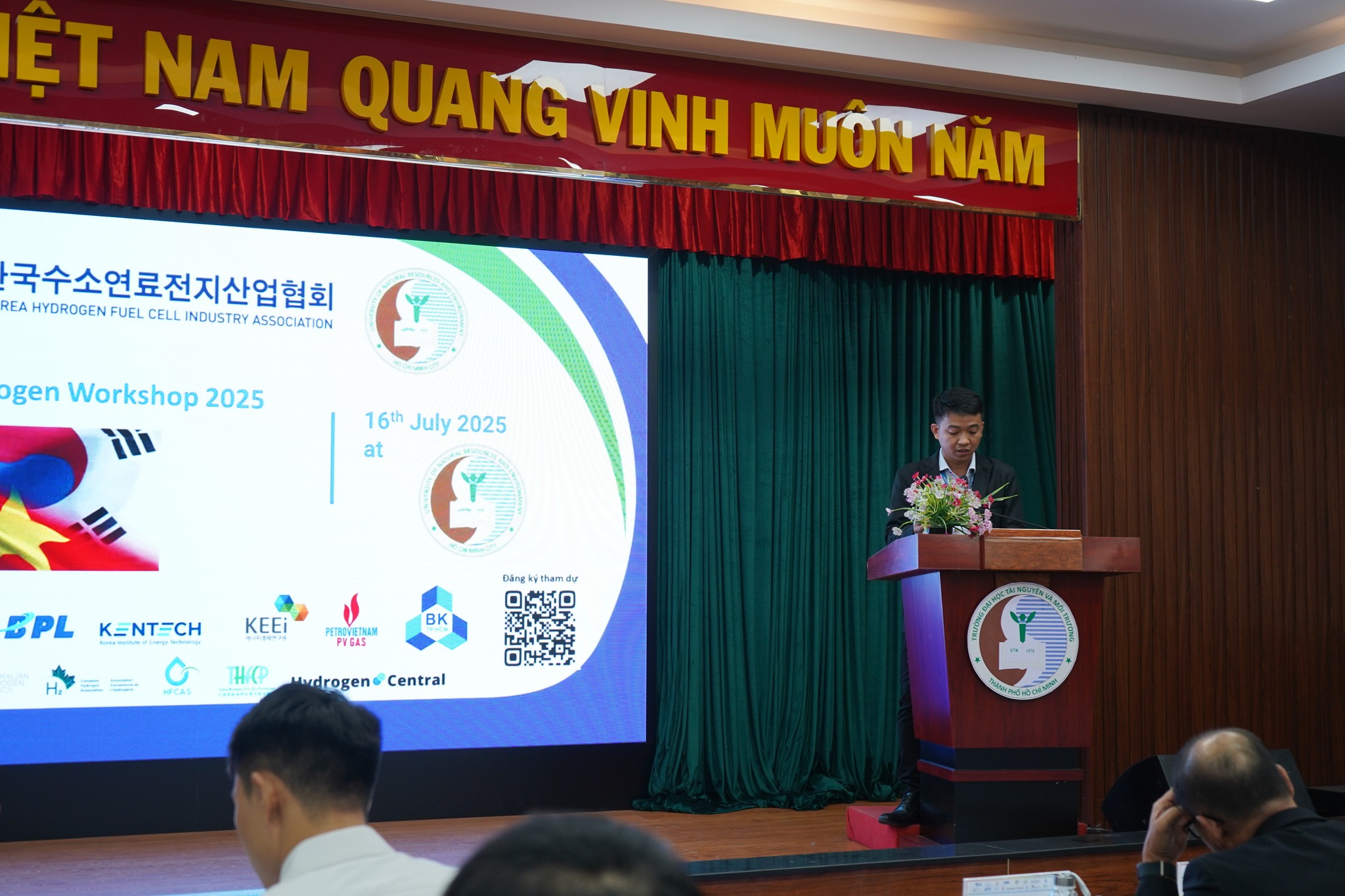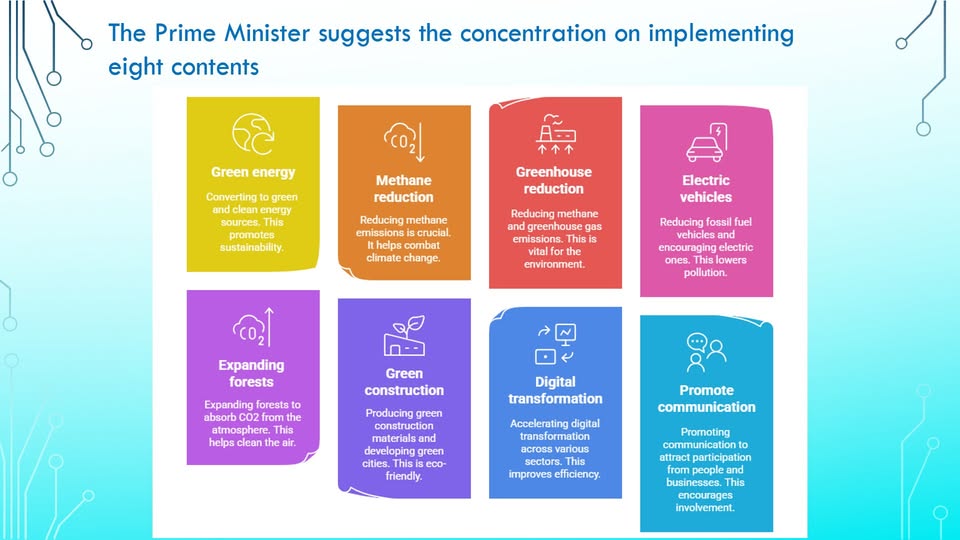Vietnam Sets Strategic Net-Zero Vision at Vietnam–Korea Hydrogen Workshop
Ho Chi Minh City – July 16, 2025
By VAHC Secretariat
At the Vietnam–Korea Hydrogen Workshop held in Ho Chi Minh City on July 16, 2025, Dr. Tran Thanh Tam, a lecturer at the Ho Chi Minh City University of Natural Resources and Environment, delivered a deeply insightful presentation that articulated Vietnam’s policy orientation and roadmap toward achieving Net-Zero emissions by 2050. His presentation stood out for its comprehensive framing of Vietnam’s climate strategy—blending legal reform, international cooperation, and the rise of hydrogen as a key decarbonization pillar.

From Political Commitment to Institutional Transformation
Opening his presentation, Dr. Tam made clear that Vietnam’s net-zero pledge at COP26 is not merely a political statement, but a national transformation agenda in motion. "Vietnam is no longer an observer in the global clean energy transition," he declared. "We are taking deliberate steps—both in legislation and in market design—to lead responsibly."
To support this claim, he cited a series of policy milestones adopted in the past three years. These include the approval of Power Development Plan VIII (PDP8), the launch of the National Hydrogen Strategy, and key resolutions from the Politburo on legal reform, innovation, and green growth. According to Dr. Tam, these documents form an interlocking framework for a transition that must be “as systemic as it is strategic.”
Two Scenarios, One Destination
A central theme in Dr. Tam’s presentation was the dual-scenario roadmap developed by Vietnamese policymakers. The country is weighing two realistic—but differentiated—development pathways:
-
The DOM Scenario: a domestically-led model grounded in national resources, gradual improvements in energy efficiency, and moderate uptake of new technology;
-
The NET Scenario: a bold internationalist model that aligns with Vietnam’s COP26 commitments and requires deep global cooperation on finance, clean technologies, and institutional strengthening.
Both, Dr. Tam argued, are technically feasible. But the NET Scenario, while more demanding, offers a chance for Vietnam to position itself as a serious player in the global green economy, especially as global value chains are restructured around low-carbon standards.
Hydrogen: Not a Future Concept—But a Present Action
While solar and wind have dominated the early wave of Vietnam’s renewables push, hydrogen now emerges as the "second-generation enabler" in the nation's energy future. According to Dr. Tam, hydrogen is no longer a hypothetical solution—it is a real, prioritized component in Vietnam’s climate policy.
“Hydrogen is not just a clean fuel,” he said, “it’s a critical lever for decarbonizing sectors like steel, cement, and long-haul transport—where electrification is not easily feasible.”
Under the National Hydrogen Development Strategy (Decision 165/QD-TTg), Vietnam has laid out specific production targets:
-
By 2030: 100,000 to 500,000 tons of clean hydrogen per year;
-
By 2050: 10 to 20 million tons annually.
He emphasized that Decree 58/2025/ND-CP, passed earlier this year, lays the legal groundwork for incentivizing hydrogen through land allocation, investment access, and integration into the national energy system. He noted that Vietnam could benefit immensely from South Korea’s experience in fuel cell deployment, hydrogen logistics, and certification systems—particularly in scaling green hydrogen cost-effectively.

Legal Architecture as the Backbone of Net-Zero Delivery
A major strength of Dr. Tam’s presentation was his detailed review of Vietnam’s evolving legal framework. Rather than vague promises, Vietnam is anchoring its climate transition in binding policies and enforceable legislation. He highlighted several key texts:
-
Decision 893/QD-TTg – the National Green Growth Action Plan (2021–2030);
-
Decree 80/2024/ND-CP – establishing the Direct Power Purchase Agreement (DPPA) mechanism;
-
Decree 58/2025/ND-CP – enabling renewable and new energy implementation under the Electricity Law;
-
Resolutions 57-NQ/TW, 66-NQ/TW, and 69/NQ-CP – focused on legal modernization, innovation, and climate-compatible governance.
These, he explained, are not “single-issue” documents, but part of a broader institutional shift—toward a regulatory ecosystem where green energy is not just encouraged, but systemically supported.
A Clear Call for International Partnership
Dr. Tam didn’t shy away from realism. Achieving Net-Zero, especially under the NET Scenario, will require substantial international cooperation. He underlined the importance of green finance mechanisms, concessional loans, carbon market access, and global technology transfer as prerequisites for success.
In this context, he praised the Vietnam–Korea Hydrogen Workshop as a timely platform to build bilateral cooperation, particularly with South Korea’s strength in hydrogen R&D, certification, and industrial application. “Our policy frameworks are ready,” he said. “What we need is deeper collaboration to go from ambition to implementation.”
Conclusion: From Vision to Action
Dr. Tran Thanh Tam closed his presentation by reminding participants that Vietnam’s climate journey is not a sprint—but a generational commitment. Net-Zero by 2050 is not a rhetorical finish line, but a “strategic anchor” that will shape national planning, institutional reform, and international positioning for decades.
His remarks resonated deeply with the audience, many of whom recognized the presentation as a clear roadmap—not only for Vietnam’s transition, but as a model for other ASEAN nations seeking to navigate the complexities of climate ambition, energy security, and green growth.





